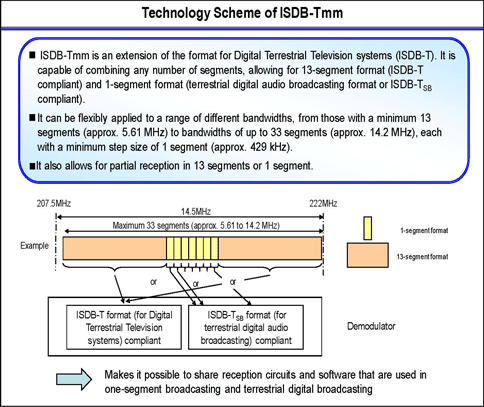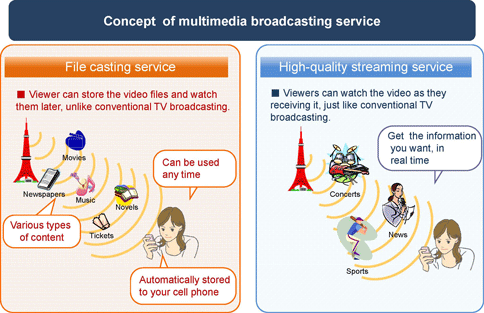ISDB-Tmm Adopted for Mobile Multimedia Broadcasting in Japan
Thursday, December 24th, 2009ISDB-Tmm has been adopted as one of the standards for nationwide mobile multimedia broadcasting in Japan. Broadcasting using this standard is aimed at viewers across the country, and is scheduled to start after July 24, 2011, at which time current analog TV broadcasting will close down. ISDB-Tmm technology is highly compatible with ISDB-T, which is the standard for the Japanese terrestrial digital broadcasting and in operation from 2003. This technology is being actively promoted by the ISDB-T Multimedia Forum, a group made up of approximately 80 Japanese corporations, and thus it is almost certain that the use of ISDB-Tmm technology for broadcasting will become a reality.
In regards to the application of ISDB-Tmm for multimedia broadcasting, nationwide broadcasting is scheduled to use 207.5-222 MHz, while VHF band 90-108 MHz will be used for regional broadcasting. In addition to the ISDB-Tmm standard, MediaFLO has also been adopted for nationwide broadcasting, and ISDB-TSB for regional broadcasting. ISDB-TSB is highly compatible with ISDB-T and ISDB-Tmm, making it possible to broadcast over a narrow bandwidth. ISDB-T, ISDB-Tmm and ISDB-TSB standards were developed with the same technology to form the “ISDB-T family”.

ISDB-Tmm eliminates the need for a guard band by combining some block of 13 segments (approx. 5.6 MHz) and several 1 segments (1 segment = approx. 0.4 MHz), and can be applied to various different bands of frequency. In preparation for the start of ISDB-Tmm, a transmitter capable of transmitting a combination of 33 segments (14.2 MHz) has already been developed. This device can fully handle the frequency band (14.5 MHz) specified for mobile multimedia broadcasting, thereby significantly reducing transmission costs.
As is clearly shown above, the versatility of ISDB-Tmm enables it to be flexibly applied to a wide range of operating frequency bands, as well as support spectrum allocations for 7 MHz and 8 MHz bands.
In conclusion, ISDB-Tmm is highly compatible with the format used for digital terrestrial television systems (ISDB-T). In addition, it offers a means for optimizing the benefits of sharing resources to develop receivers and using combined transmissions adapted to the dedicated bandwidth of each country. For these reasons ISDB-Tmm is considered to be the ideal multimedia broadcasting system for countries, including those in South America, that have already adopted ISDB-T for Digital Terrestrial Television systems.

Latest News
- Barb to start reporting TV-set viewing of YouTube channels
- SAT FILM selects multi-DRM from CryptoGuard
- Qvest and ARABSAT to launch OTT streaming platform
- ArabyAds & LG Ad Solutions partner with TVekstra in Turkey
- Freeview NZ satellite TV service to move to Koreasat 6
- Comscore expands YouTube CTV measurement internationally
